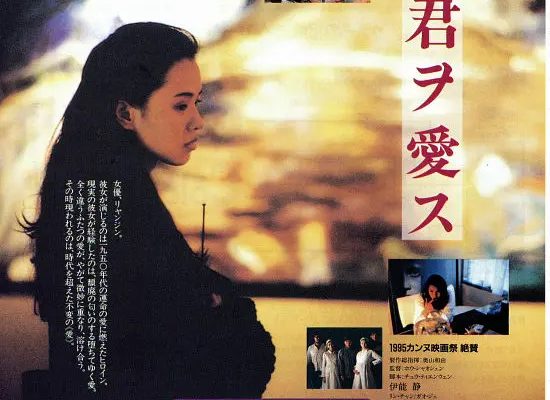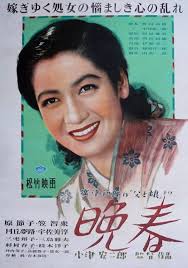
Zhen Zhang argues that Pema’s films are Poetic rather than realistic or lyrical compare to his sixth-generation peer directors and Tibetan fellow artists.(Bernett,16) I think the poeticality of Pema’s works is reflected in the following two aspects:
1, Visual and narrative formalism
Like good poems, Pema’s films rely on the visual and narrative form more that on the linear storytelling. In Jinpa, he uses a 4: 3 frame to layout symmetrical spatial structure and narrative structure in order to tell symmetrical stories with an open ending. He resists the linear narrative by repeating, retelling the same story. The search unifies multilayer story with the same theme: director searching for the actors; girl searching for her ex-boyfriend; businessman searching for his lost love; cameraman searching for a movie. In The search Pema also explores the transformation of narrative forms from folklore to the film; from documentary realism to filmic fiction: The film making is supposed to do the storytelling, but censorship makes it difficult, Pema deliberately tells the central story by oral narration, using this traditional way of storytelling to contrast the obvious absence of film art.
In both films, Pema uses the journey as structuring metaphors, as a journey to find his own cultural identity. The Landscape of Tibetan is used as an index for emotion and as a form of value statement, a device found in exotic films, (Bernett,16) Pema defamiliarize the exotic perspective of Tibetan landscape by the still, or even dull cinematography. He applies a lot of medium and long-term shots, almost no close-ups in both Jinpa and The search. The characters wander about like ghosts on Tibetan land, the unique landscape has become the focus of the cinematography in both films. In the ending scene of The search, where the girl meets her ex-boyfriend on the playground, students are spinning in the folkdance circle, the lovers meet in the middle of the picture. The focus should be on the couple, but the director refuses to do so, he seems to be deliberately fighting against the commercial cinematic language. The shot which should have been the climax of a movie seems too peaceful, and the composition of this shot reveals certain uniqueness within Tibetan culture, or we may call it the unique structure of feelings.
2, The structure of feelings
A structure of feeling is “alternative perceptions of others, in immediate relationships; new perceptions and practices of the material world” (Williams,126).In other words, the structure of feeling is about the ephemerality of certain material world and the ways to perceive it. Bernett says this is a movie about “omission”, we can see it in a more constructive way as the narration of absence. In meanwhile, the film is looking for various ways of archiving in the material world: businessman’s lost love story is archived by the empty house on the slope, the all-male performance in the temple is archived by VCD, and the traditional drama is archived by the actors’ bodies, the girl and her ex-boy friend’s story is archived by the purple scarf, and the search process is archived by the handheld DV. All these archives complete the absence, in this case, the narration of absence has exceeded the “omission” and conveys new meaning. A failure of search is a success of archiving. The irreplaceability of the Tibetan film making is consistent with the purpose of preserving the story of Drime Kunden: to record the structure of feeling of this unique nation.
The girl with a scarf is considered to be the embodiment of Tibetan culture identity, but when the director asks the businessman to tell his story on the road, the girl is not on the picture of the passengers, she is blocked by the storyteller and appears on the reflection of the glass. She is everywhere but in meantime illusive. Bernett claims that the commodity in Pema’s film is the locus of disruptive desire and modernity: The purple scarf is a fetishized object, the evidence of the ephemeral, once it’s unveiled, the girl is gone. It seems like a failed search because the girl does not show her face at all, even in the archive (the photo). However, you can say that the search of the beautiful face of Tibetan culture has not yet come to an end. Bernett maintains that in The search Pema reveals the constructive nature of culture and the way that once it takes embodied finished form, it is already in the past. ( Bernett, 25)But I want to argue that the world making of Tibetan culture can only be realized in constant archiving/film making, or at list in the promises of film making. The exploration of this unique structure of feeling in Jinpa becomes more obvious, the contradiction between duty and humanity, and how to reconcile it to fulfill the revenge, it is both unique and universal.
If the story of Drime Kunden is about the past, then the ghostly existence of the girl is not about the past, it is the reckoning of the past, The ghost’s desire is not just the return of the past or dead, the ghostly matter is always “waiting for you, and its motivation, desire, and the intervention are remarkable only for being current.” (Gordon,183) or in other words, the ghost’s desire is about the immediate relationships and perception of the material world, about the structure of feelings.
Williams, R. Marxism and Literature. Marxist Introductions. OUP Oxford, 1977.
Gordon, A.F. Ghostly Matters: Haunting and the Sociological Imagination. University of Minnesota Press, 2008.




